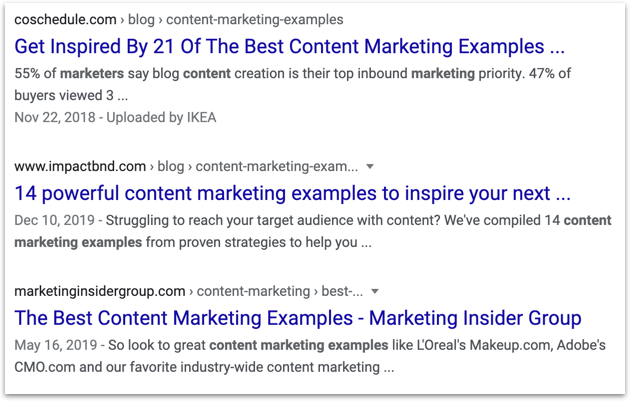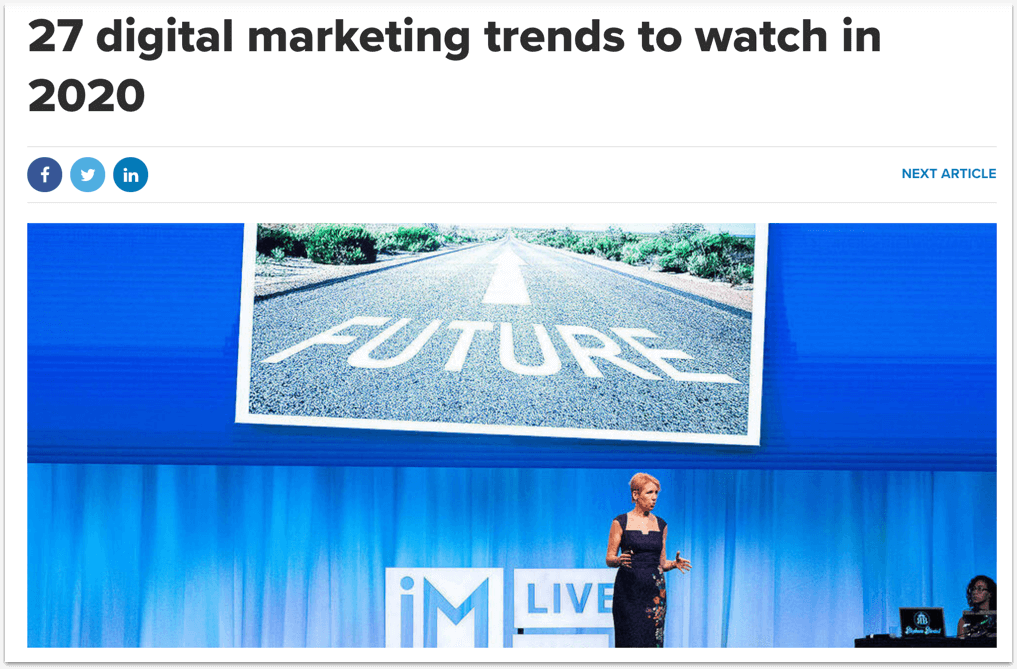Topics:
Content MarketingSubscribe now and get the latest podcast releases delivered straight to your inbox.
How to write memorable business blog posts
- Build trust with your introduction
- Publicly declare your biases
- Craft titles that stand out
- Don’t overlook your meta description
- Speak directly to your audience
- Show off your people and their personalities
- Identify your crutch words and find alternatives
- Use original imagery
- Repurpose the blog information into a visual format
- Create a conversation
Once upon a time, content marketing and business blogging were like the iconic movie, Field of Dreams...

If you built a blog, visitors would come.
Now, in 2020, content marketing is the norm. Not having a blog in 2020 is like not having a website 10 years ago.
So yes, you’re creating content, but so are all of your competitors.
That means you can no longer just write a blog post and expect to see a major increase in traffic, lots of new qualified leads, and a big uptick in sales. You have to write truly great content that stands out and speaks to your ideal buyers.
One part of that equation is having the in-house expertise and knowledge to become the best teachers in your space. This article won’t help you with that.
🔎 Related: How to write a blog (+ free blog post template and tools)
But I can teach you the other part of the equation — how to leverage that knowledge in an effective way.
After reading and reviewing several hundred articles for clients as a content trainer for IMPACT, I’ve seen articles that stand out and articles that I forget immediately. When that ideal buyer is comparing you and your top competitors online, you need your content to seize their attention and render every other article forgettable.
These are the top ten ways to make unforgettable blog posts that will make readers stick around and keep learning on your site.
Build trust with your introduction
I can’t tell you how many times introductions are written hastily just to provide a quick overview of what an article is about. Nothing wastes the energy that you’ve spent writing a thoroughly researched and well written blog article like a lackluster introduction.
If you’re looking into your blog analytics and see a very short, less than 30 seconds, time on page metric coupled with a high bounce rate - it’s a problem with your introduction.
🔎 Related: 3 fun ways to write blog introductions that are memorable
Your introduction is your biggest make or break opportunity to convince the audience to read your article.
Read through your introduction from the perspective of your ideal buyer. From this vantage point, ask yourself these questions:
- Does this writer understand me? Do they know my problems? Do they know why I’m here?
- Does this company offer a bonafide solution to my problems?
- Do they give me any indication that I can trust what they’re saying?
Your introduction should be able to leave the reader responding with resounding yes to all of these questions. Please note that I said “all.” You need to check all three of these boxes to get the reader to go past your introduction.
Publicly declare your biases
One of the most frustrating parts of reading blogs is when they’re a thinly-veiled disguise for a sales pitch. You’ve read those blogs that you thought would be super helpful that quickly devolves into blunt force head trauma courtesy of a 2x4 of a sales pitch.
One of the best ways to make sure that your reader doesn’t feel this way is to be upfront and share your interest in writing this article.
To provide an example, let’s use one of the most unquestionably underrated ways to improve your life: bamboo bedding. (FYI: I. Love. Bamboo. Bedding.)
I decide to start a small business that specializes in bamboo bedding. My shop isn’t going to sell inferior products like cotton or polyester bedding. The success of my business relies on educating consumers about the clear superiority of bamboo bedding.
One of the first articles I write compares bamboo bed sheets to cotton bed sheets. If the first time that I mention the fact that I only sell bamboo bed sheets is in the conclusion when I’m asking you to buy them, you’re going to be on edge. Everything that you’ve read and may have agreed with is now looked at with a touch of bias.
But let’s say I’m writing that exact same article, but include a statement that eliminates the feeling of bias (probably somewhere in the introduction.)
That might look like this “Here at Brian’s Bedding, we specialize exclusively in bamboo bed sheets. We believe wholeheartedly in the benefits of bamboo sheets, but we understand they aren’t for everyone. To help you pick the sheets that will be best for your home, we’re going to provide you with an honest evaluation of bamboo bed sheets and the most common alternative, cotton sheets.”
By addressing the bias that you might have in writing this article, you build trust with the reader. They’ll understand that while you have something to gain by writing the article, that it’ll also be helpful for them. And when you ask them to take that inevitable next step, they won’t be caught off guard.
Craft titles that stand out
Primary keywords and pulling SEO levers don’t equate to a great title. Because your title will be the only Header 1 on the page, you will want to pay attention to SEO. It’s always best practice to Include a front-loaded keyword in your title to give yourself the best chance to rank.
But after that, write enticing copy that stands out from top results on Google. Think about how you can use your title to generate interest and highlight the value of the article. Enticing copy is not to be confused with clickbait. If you read your proposed title and it sounds like something that you’d see on Facebook that would lead you to a spam-filled slideshow, it’s probably clickbait.
Instead, you can follow a few different strategies to create more clickable titles.
- Write your title in the form of the question someone would ask to lead them to your article. With the rise in voice search, titles with conversational questions are more likely to be found.
- Use unique words that break through the monotony of other titles on page 1 of Google. Instead of using words like “best”, you could use “strongest” or “longest lasting.” Finding alternative words that people see less often will help your title stand out.
- Use a two-part title to show the specific value of your article. Think about the 55-65 characters of your title as real estate that you want to use entirely. The second part of your title could be after a question mark, semicolon, or even included in brackets. Use this space to show the value or context of your article.
So using strategies 1 & 3, a title like “Website Redesign Cost | IMPACT Branding & Design” could end up like this “How much do website redesigns cost? A pricing breakdown.”
Don’t overlook your meta description
Think of meta descriptions as your elevator pitch to all searchers on Google that explains why they should click your link versus all others. At first glance, this may sound a bit like crafting titles that stand out. But keep in mind that with titles you will have a lot of similarities because you’re targeting a specific keyword like everyone else.
You might be clued into having an issue with your meta description if you’re ranking well for terms, but not getting your anticipated click rate. By creating better meta descriptions, you can increase the number of people clicking to your article and not the other nine options on Google.
Question and answer formats work great for meta descriptions. Consider asking a question that your ideal reader might be asking themself on the topic and then preview how this blog will help them answer that specific question.
Imagine you’re looking for content marketing examples. Take a look at the meta descriptions below.

Which one would you click?
The first example shows a couple of random facts loosely related to the topic. The third example seems to start in the middle of a thought that leaves you confused.
The middle example speaks to the reason you’re probably searching for content marketing examples. The question and answer format tells you exactly what this blog contains. Lastly, the meta description conveys a complete thought and leaves you curious to learn more.
Using the Portent SERP Preview Tool can also show you when Google is likely to truncate your meta description based on character count. Make sure that your meta description isn’t cut off in the middle of a very important thought that leaves someone unclear about what you’re saying.

In the example above, the reader knows exactly what this article is about. Even though the entire meta description gets cut off, the value of the article is shown.
You may be saying to yourself, “Well why wouldn’t I just write a shorter meta description and avoid getting cut off entirely?” And that is a valid question.
Even though Google will likely cut off your title at around 155-165 characters, there is a chance that up to 300 characters could be shown. So using the entire 300 characters of potential real estate never hurts you.
Speak directly to your audience
Clients all the time express the worry they have in writing to a very direct audience. They’re scared that if they write too specifically or narrowly, they’ll alienate a portion of their potential prospect base. The risk that you actually run though when you don’t write directly to your specific audience is that those ideal prospects don’t understand if you’re a good fit.
When I say speak directly to your audience, it means that that member of your ideal audience is on the other side of the article and is saying “OK, they understand me.”
This reaction can be evoked in several ways. You could describe a situation that the reader finds themselves in based on their role or job function. You can speak to the struggles or problems that a specific person might have that your solution is a great fit for.
Really it comes down to understanding who exactly is reading your article and what brought them here. A great exercise to follow to help get into the head of your reader is the Content Compass.
Show off your people and their personalities
Liz Moorehead always asks me “Could anyone other than Brian Casey have written this article?” If the answer is no, I have to go back to the drawing board. But why is this important?
If you believe that your people are your greatest asset or differentiator at your company, please stand up? You may now be seated. I bet that if I opened up your company blog, every article would sound exactly the same, even if they have different authors. That's a huge problem.
Every company should have an agreed-upon content style guide to direct how your brand should be perceived. But within those boundaries, you want the individual personalities of your people to shine through.
Encourage them to use their natural voices, mannerisms, and share experiences and examples from their lives. As a content therapy survivor, I do want to warn you that figuring how to bring your genuine personality into your writing is painful. You’ll have to fight urges to sound like the buttoned-up professional you think business blogging requires.
But bringing out the personality of every writer has big benefits.
By providing the space to have every individual personality stand out in your content, you allow prospects and customers to get to know the people that make your business unique. They can begin to build a relationship without ever having met the writer in person.
All things equal, people choose to do business with people they know and like. Highlighting your brand personality and the individuals that make it that way can give you the leg up you need.
Identify your crutch words and find alternatives
Every writer has words that they feel comfortable with that they tend to use multiple times in the same article, or from article to article. These words are what I refer to as “crutch words” that writers lean on, but can weaken the overall strength of any article.
When a reader continues to see the same words over and over again, they start to check out because the writing seems mundane and repetitive.
Using a keyword density tool, you can easily identify those words that you might be using too often. Ignore the words with a high density like “the” or “and”, and pay attention to how often you’re using the same word in an article. It’s also worth noting that some keywords will naturally show up more often because they’re closely related to the keyword or topic you’re writing around.
A great example of one of my crutch words in the article, “13 best website copywriting tips for digital marketers,” is the word “understand” that I use 18 times. There are so many simple alternatives that I can choose that won’t have the reader saying “here he goes again.”
Use original imagery
How many people do you think have used that same picture of a man typing on his computer or a woman giving a presentation in front of her colleagues? There are only so many images on stock image websites that can show up when you search for “typing on a computer” or “business presentation”.
Using stock photography can not only be duplicated across different websites, but also on your own website. How well do you think a new site visitor is going to feel like you’re writing great original content if they see the same generic picture more than once on your website?

It’s never been easier to create original images without needing to invest in expensive equipment. The photo quality on most smartphones is often good enough to be used on your website.
Original images not only help you stand out from the crowd but can also build trust by introducing readers to the people that make your business so special. Instead of looking at canned images of models, readers can see the people they will interact with and start to form a relationship.
For my article on digital marketing trends in 2020, I scoured through the images that our team took at IMPACT Live 2019. After some digging, I was able to find a perfect image to complement my article, while subtly promoting our event as well.
Repurpose blog information into a visual format
In the world of education, which you should consider yourself in as someone writing blogs, there are four widely accepted types of learners. The VARK model teaches us that people learn best visually, with audio, through written language, or by experiencing things firsthand. The large majority, 65% identify themselves as visual learners.
So why does this matter for blog writers?
Well, the reality is that few people are going to sit down and read every one of the 1,000 words you’ve written about a topic, even if it’s important to them. Beyond that, just writing about a topic doesn’t lend itself to helping your site visitors learn in a way that they enjoy.
The solution is to include videos and images in your blog to allow someone to digest the information in front of them exactly how they want to. This could mean creating a quick graph that visually represents facts and figures you’ve written down. You may create an infographic as a fun and stimulating way to present information.
The best way, however, is to repurpose your blog information is by creating video content. Videos are proven to increase your conversion rate and to help visitors retain information.
Create a conversation
Blog posts can very quickly become a one-way discussion where the writer is teaching and the reader is learning. But the best content finds a way to create a back and forth dialogue with the reader.
So what does this look like in practice?
Simply ask questions. When you ask a question your reader has to receive the information and come up with a response. Their internal voice begins answering the question similarly to how they would if they were asked the question in person.
At this point, you as the writer aren’t just telling them things but allowing the reader to be an active participant in the conversation you’ve created.
Take a look at this article from Industrial Packaging and how the writer asks questions to engage the audience. The article feels more like a two-way exchange versus just information being dictated to you.

How you can create better blog posts
I get it. This is a lot to take in and you’re probably going to have to change up a good amount of your traditional blogging process. But you’re not here to continue cranking out blogs that don’t get you any closer to your sales goal.
These proven tips have led to success with clients of every shape and size. When I say success, I mean increased sales from more highly-qualified prospects.
If you’re tired of wasting time and money with content marketing, you need to push through the comfort zone that your blog lives in.
Don’t just sit there nodding your head and not actually do something about it. Start implementing these tips right away to see better results.


Order Your Copy of Marcus Sheridan's New Book — Endless Customers!
.png?width=50&height=50&name=Brian%20(1).png)
